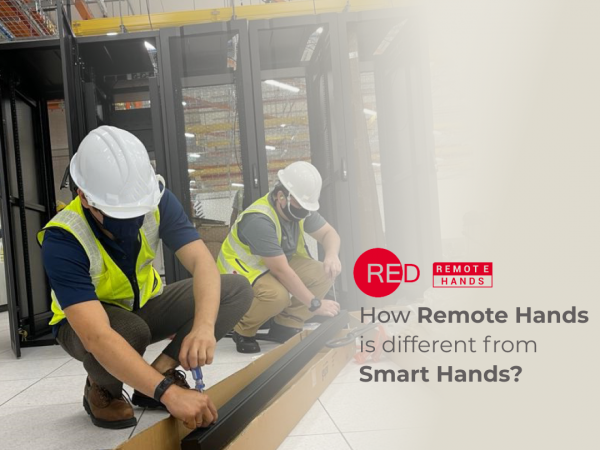
Red Remote Hands in action
The continued surge in the use of digital technologies over the last few years has resulted in an increase in the need for not only data center infrastructure but also its related services. Increasingly organizations are moving on-premise applications into the cloud and more reliable cloud computing service providers are offering turnkey services to take care of it. The pandemic, with its increased demand for online media for entertainment and working from home business use, has accelerated this adoption. People and organizations all over the world have had to adjust to new ways of work and life.
The essential businesses that support the critical infrastructure for businesses have to go on even during this challenging time. This is where Remote Hands and Smart Hands services can assist.
The term Remote Hands and Smart Hands are used loosely and interchangeably in the data center world. If you are confused about the difference between them, in this 2nd Part of our series, we clear up the confusion as to what exactly are Remote Hands and Smart Hands.
If you haven’t read Part 1, What is Remote Hands? You can find the link at the end of this article.
What is Remote Hands Services?
Remote Hands service is physical basic tasks carried out remotely without the presence of the clients. These support tasks include patching cabling, visual checking of ports, observing and reporting light status indicators on equipment, environment monitoring, and server reboots. This is known as a Level 1 service.
Remote Hands services may include tasks that are straightforward in nature such as:
- Rebooting of servers.
- Checking and monitoring of ports.
- Equipment and environmental physical observation,
- Describing and reporting on indicators or display information on equipment or consoles, etc.
- Inventory and labeling management
- Physical escorting of site visits
- Backup tape management
- Shipping and receiving of goods or deliveries
Smart Hands, on the other hand, are known as the Level 2 support services. These require IT technical knowledge in handling equipment, testing, configuration, and troubleshooting. Some of the Smart Hands tasks include:
- Network and system OS configuring
- Equipment testing, troubleshooting, and complex cable configurations
- Racking and stacking
- Moving equipment within your space and cabinets
- X-Connects support and management
- Server replacement
- Optics installation and testing
Remote Hands service, being straightforward in nature, is traditionally provided by data center providers, while Smart Hands being more complex in nature are commonly provided through another party.
Remote Hands and Smart Hands are exceptionally useful to an organization when it isn’t possible for their staff to access the equipment, for example, remote sites or overseas locations.
Choosing a reliable partner with the knowledge, experience, and skillsets to provide both Remote Hands and Smart Hands is crucial for the success of projects and ongoing business operations.
Regardless of the terminology used, Remote Hands or Smart Hands, we combine the two services into one, to seamlessly support all the technical needs of our clients.
This comes to the end of Part 2: Difference between Smart Hands & Remote Hands. I hope it might clear all your doubts regarding both services.
Drop your comment if I have left any questions unanswered.
Till then, stay safe & stay tuned for Part 3 of the series where I will be covering everything about Remote Hands.
PS: Our Remote Hands team covers countries across the Asia Pacific and offers both Remote Hands as well as Smart Hands Services. Let us show you how we can assist you with all your remote projects and operations, while you focus on your core business. To contact us click here.
PS: Click on the link to read Part 1: How Remote Hands can help you during pandemic time.




